Today Current Affairs: 17th December 2021 for UPSC IAS exams, State PSC exams, SSC CGL, State SSC, RRB, Railways, Banking Exam & IBPS, etc
Table of Contents
Mutual Legal Assistance Treaty: India- Poland

The Union Cabinet has approved the Treaty on Mutual Legal Assistance in Criminal Matters between the Government of India and Poland.
Mutual Legal Assistance Treaties (MLATs):
- The MLATs in criminal matters are the bilateral treaties entered between the countries for providing international cooperation and assistance.
- These agreements allow for the exchange of evidence and information in criminal and related matters between the signing countries.
Benefits of Treaty:
- Investigation and Prosecution of Crime: It will enhance effectiveness of both the countries in investigation and prosecution of crime, through cooperation and mutual legal assistance in criminal matters.
- Transnational Crime and its Linkages to Terrorism: It will provide a broad legal framework for bilateral cooperation with Poland in investigation and prosecution of crime as well as in tracing, restrain and confiscation of proceeds and instruments of crime as well as the funds meant to finance terrorist acts.
- Gaining Better Inputs: It will be instrumental in gaining better inputs and insights in the modus operandi of organized criminals and terrorists.
- These in turn can be used to fine tune policy decisions in the field of internal security.
- The Ministry of Home Affairs is the nodal Ministry and the Central authority for seeking and providing mutual legal assistance in criminal law matters.
- The Ministry of External Affairs may be involved in this process when such requests are routed through diplomatic channels by these Ministries.
- Section 105 of the Criminal Procedure Code (CrPC) speaks of reciprocal arrangements to be made by the Central Government with the Foreign Governments with regard to the service of summons/warrants/judicial processes.
- India has entered into Mutual Legal Assistance Treaties/Agreements with 42 countries (November 2019).
Green Hydrogen Microgrid Project:

NTPC Limited announced that India’s first Green Hydrogen Microgrid Projects will be set up at Simhadri near Visakhapatnam in Andhra Pradesh.
- The projects will be a precursor to large-scale hydrogen energy storage projects and would be useful for studying and deploying multiple microgrids in various off-grid and strategic locations of the country.
- The hydrogen produced during sunshine hours will be stored at high pressure and electrified using a 50 Kilo Watt Solid Oxide Fuel Cell.
- The system will work in standalone mode from 5 PM in the evening to 7 AM in the morning.
- This unique project for India, will open doors for decarbonising the far-off regions of the country like Ladakh and Jammu and Kashmir.
Pradhan Mantri Krishi Sinchayee Yojana:
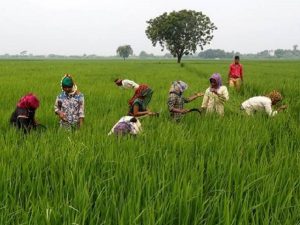
The Cabinet Committee on Economic Affairs chaired by the Prime Minister Shri Narendra Modi, has today approved implementation of Pradhan Mantri Krishi Sinchayee Yojana (PMKSY) for 2021-26 with an outlay of Rs.93,068 crore.
- The CCEA has approved central support of Rs.37,454 crore to States and Rs.20,434.56 crore of debt servicing for loan availed by Government of India for irrigation development during PMKSY 2016-21.
- Accelerated Irrigation Benefit Programme (AIBP), Har Khet ko Paani (HKKP) and Watershed Development components have been approved for continuation during 2021-26.
- Central funding of 90% of water component for two national projects, namely Renukaji Dam Project (Himachal Pradesh) and Lakhwar Multipurpose Project (Uttarakhand) has been provisioned.
- Launched in 2015, PMKSY is an umbrella scheme, providing central grants to the State Governments for specific activities detailed below.
- It consists of two major components by Department of Water Resources, River Development and Ganga Rejuvenation, namely, Accelerated Irrigation Benefits Programme (AIBP), and Har Khet Ko Pani (HKKP).
- HKKP, in turn, consists of four sub – components, being Command Area Development (CAD), Surface Minor Irrigation (SMI), Repair, Renovation and Restoration (RRR) of Water Bodies, and Ground Water Development. In addition, Watershed Development part is being implemented by Department of Land Resources.
- Another component of PMKSY, Per Drop More Crop is being implemented by Department of Agriculture and Farmers Welfare.
Atmanirbhar Bharat Rojgar Yojana:
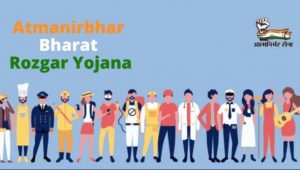
Maharashtra has topped the list of states with maximum number of beneficiaries under the Atmanirbhar Bharat Rojgar Yojana (ABRY), followed by Tamil Nadu and Gujarat.
- It was launched in November 2020 to boost employment in the formal sector and incentivize creation of new employment opportunities during the Covid-19 recovery phase under Atmanirbhar Bharat Package 3.0.
- It provides subsidy for provident fund contribution for adding new employees to establishments registered with the Employees’ Provident Fund Organization (EPFO).
- The organizations of up to 1000 employees would receive employee’s contribution (12% of wages) & employer’s contributions (12% of wages), totalling 24% of wages, for two years.
- Employers with over 1,000 employees will get employees’ contribution of 12%, for two years.
- The subsidy amount under the scheme will be credited upfront only in Aadhaar-seeded EPFO accounts (UAN) of new employees.
- Establishments registered with EPFO will be eligible for the benefits if they add new employees compared to the reference base of employees as in September 2020.
- Establishments, with up to 50 employees, would have to add a minimum of two new employees.
- The organizations, with more than 50 employees, would have to add at least five employees.
- Any new employee joining employment in EPFO registered establishments on monthly wages less than Rs. 15,000.
- Those who left their job between 1st March to 30th September 2020 and are employed on or after 1st October 2020.
Sardar Vallabhbhai Patel:

Prime Minister paid tribute to India’s first home minister, Sardar Vallabhbhai Patel, on his 71st death anniversary on 15th December.
- Born: 31st October 1875 in Nadiad, Gujarat.
First Home Minister and Deputy Prime Minister of India. - He always requested the people of India to live together by uniting (Ek Bharat) in order to create a foremost India (Shresth Bharat).
- This ideology still reflects in the Atmanirbhar Bharat initiative which seeks to make India Self-Reliant.
- Headed various Committees of the Constituent Assembly of India, namely:
- Advisory Committee on Fundamental Rights.
- Committee on Minorities and Tribal and Excluded Areas.
- Provincial Constitution Committee.
- He worked extensively against alcohol consumption, untouchability, caste discrimination and for women emancipation in Gujarat and outside.
- Integrated the farmer’s cause in Kheda Satyagraha (1918) and Bardoli Satyagraha (1928) with the national freedom movement.
- Women of Bardoli bestowed the title ‘Sardar’ on Vallabhbhai Patel, which means ‘a Chief or a Leader’.
- Remembered as the ‘Patron Saint of India’s Civil Servants’ as he established the modern all-India services system.
- As India’s first Home Minister and Deputy Prime Minister, Sardar Patel played a key role in the integration of about 565 princely states into the Indian Union.
- Few princely states like Travancore, Hyderabad, Junagadh, Bhopal and Kashmir were averse to joining the state of India.
- Sardar Patel worked tirelessly to build a consensus with the princely states but did not hesitate in employing methods of Sama, Dama, Dand and Bhed wherever necessary.
- He had used force to annex princely states of Junagadh ruled by Nawab and Hyderabad ruled by Nizam, both of whom had wished not to merge their respective states with the Union of India.
- Sardar Vallabhbhai Patel stitched the princely states along with British Indian territory and prevented the balkanization of India.
- Known as the “Iron Man of India” for playing an important role in unification and integration of Indian princely states into the Indian federation and for convincing princely states to align with the Indian Union.
- Death:15th December 1950 in Bombay.
Parker Solar Probe: NASA

The Parker Solar Probe, launched by NASA, has become the first spacecraft to fly through the outer atmosphere of the Sun- ‘Corona’.
- The spacecraft flew through Corona and sampled magnetic fields and particles there.
- The achievement would help scientists discover critical information about the sun and its influence on our solar system.
- Launched in 2018, Parker Solar Probe will travel through the sun’s atmosphere, closer to the surface than any spacecraft before it, facing brutal heat and radiation conditions — and ultimately providing humanity with the closest-ever observations of a star.
- In order to unlock the mysteries of the sun’s atmosphere, Parker Solar Probe will use Venus’ gravity during seven flybys over nearly seven years to gradually bring its orbit closer to the sun.
- The spacecraft will fly through the sun’s atmosphere as close as 3.9 million miles to our star’s surface, well within the orbit of Mercury and more than seven times closer than any spacecraft has come before.
Parker Solar Probe has three detailed science objectives:
- Trace the flow of energy that heats and accelerates the solar corona and solar wind.
- Determine the structure and dynamics of the plasma and magnetic fields at the sources of the solar wind.
- Explore mechanisms that accelerate and transport energetic particles.
RBI Allows Payments Banks, Small Finance Banks To Conduct Govt Agency Business:
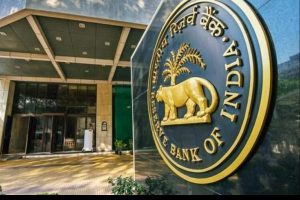
It will be subject to the condition that the concerned bank is not under the Prompt Corrective Action (PCA) framework or moratorium.
- The choice of accrediting an agency bank (including scheduled private sector agency bank) for any particular government agency business rests solely with the concerned Central Government Departments /State Governments.
- The Bank can now participate in government and other large corporations issued Request for Proposals (RFP), primary auctions, fixed-rate and variable rate repos, and reverse repos, along with participation in Marginal Standing Facility.
- Also, the bank would now also be eligible to partner in government-run financial inclusion schemes.
- Small finance banks are financial institutions that provide financial services to the country’s underserved and unbanked areas.
- They are registered as a public limited company under the Companies Act, 2013.
- These banks, like other commercial banks, can engage in all basic banking activities, such as lending and accepting deposits.
- The NachiketMor committee on financial inclusion suggested SFBs.
- Small Finance Banks can’t extend big loans. Cannot float subsidiaries or trade in high-tech products.
- Payment banks were established to promote financial inclusion by offering; ‘modest savings accounts and payments/remittance services to migratory labour workforce, low-income households, small enterprises, other unorganised sector entities, and other users.’
- These banks can accept a restricted deposit, which is now capped at Rs 200,000 per person but could be raised in the future.
- These banks are unable to provide loans or credit cards. Banks of this type can handle both current and savings accounts.
- Payments banks can provide ATM and debit cards, as well as online and mobile banking.
Who Was Salar Masud And Raja Suhaldev?
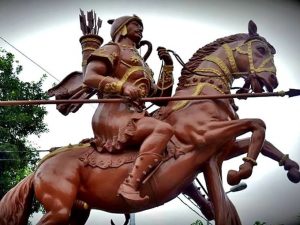
Speaking at the inaugural event of the Kashi Vishwanath Dham Corridor in Varanasi, PM Modi referred to the battle between Salar Masud and Raja Suhaldev.
Salar Masud:
- Salar Masud was also known as Ghazi Mian. He acquired popularity as a warrior in the 12th century.
- He was the nephew of the 11th century Turkik invader, Mahmud of Ghazni.
- His tomb at Bahraich in Uttar Pradesh stands as a place of pilgrimage for a large number of Muslims as well as Hindus.
- He accompanied Mahmud in all his campaigns, including the celebrated expedition to Somnath in Kathiawar. It was Masud who supposedly persuaded his uncle to demolish the famous idol of Somnath – a deed repeatedly glorified as a great feat in Persian poetry.
- The most comprehensive source of information about Ghazi Mian is the Mirat-e-Masaud (Mirror of Masaud), a 17th century Persian hagiography written by Abdur Rahman Chisti, a Sufi saint of the Chisti order.
- Mughal emperor Akbar is known to have made a land grant in 1571 CE for the sake of maintaining Ghazi Miyan’s shrine.
Salar Masud and Raja Suhaldev:
- It is a mix of history and myth.
- As per the records, at Bahraich, in the course of a battle in 1034 CE Masud and a local king by the name Suhaldev came face to face.
- During the battle, Masud was wounded by an arrow and succumbed.
- Since he died fulfilling his duties as a warrior, he became a martyr and earned the honorary nickname ‘Ghazi Miyan’ or master warrior for faith.
Raja Suhaldev:
- Suhaldev is believed to have been the eldest son of the king of the Bhar community, from which emerged the Pasi community, a Dalit caste group of the region.
- Popular history of the region identifies him by several names including Suhaldev, Sakardev, Sahardev, and Suhildev.
- In contemporary print culture, however, he is referred to as Raja Suhaldev.
Raja Chait Singh:
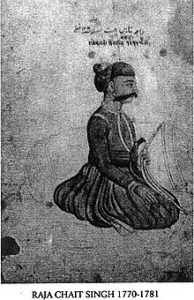
Cited by Modi in his Kashi speech.
- By the late 18th century, Benaras had declared independence from the Nawab of Awadh.
- In 1771, Maharaja Chait Singh succeeded to the throne of Banaras with the help of British authorities.
- Two years later, the Maharaja transferred the domain to the East India Company under the control of Hastings.
- When faced with the need for resources to fight the Mysore War against Hyder Ali, Hastings pressed Maharaja Chait Singh to make additional revenue payments and supply troops in 1778 and 1779.
- When Singh failed to comply, Hastings marched to Benaras with his troops to confront the king.
- Several of Hastings’ men were killed in the conflict and, left with no other option, the governor-general was forced to retreat.
- Popular narrative goes that he left hurriedly at night for the nearby Chunar Fort riding an elephant.
- The incident is believed to have given rise to the popular saying in Banaras: “Ghode par haudah, hathi par jeen, Kashi se bhaga Warren Hastings”.
Durga Puja Enters UNESCO’s ‘Intangible Cultural Heritage’ List:
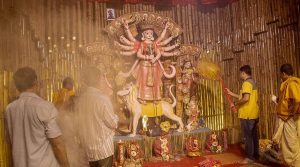
The Intergovernmental Committee for the Safeguarding of the Intangible Cultural Heritage has inscribed ‘Durga Puja in Kolkata’ on the Representative List of the Intangible Cultural Heritage of Humanity.
- This inscription will offer encouragement to the local communities that celebrate Durga Puja, including all the traditional craftspeople, designers, artists, and organizers of large-scale cultural events, as well as tourists and visitors who partake in the inclusive festivity that is Durga Puja.
- The 16th Committee of UNESCO for safeguarding of the Intangible Cultural Heritage (ICH) in its meeting held in Paris has inscribed DURGA PUJA in KOLKATA on the representative list of Intangible Cultural Heritage of Humanity.
- This is the 1st festival in Asia to achieve recognition as UNESCO ICH of Humanity.
- UNESCO’s list of intangible culture is an annual list which focuses on those forms of performing art which are of outstanding value but are vulnerable due to lack of support.
- Convention for the Safeguarding of the Intangible Cultural Heritage was adopted in 2003. India ratified it in 2007.
- In total, 14 Intangible Cultural Heritage elements from India have now been inscribed on UNESCO’s Representative List.




